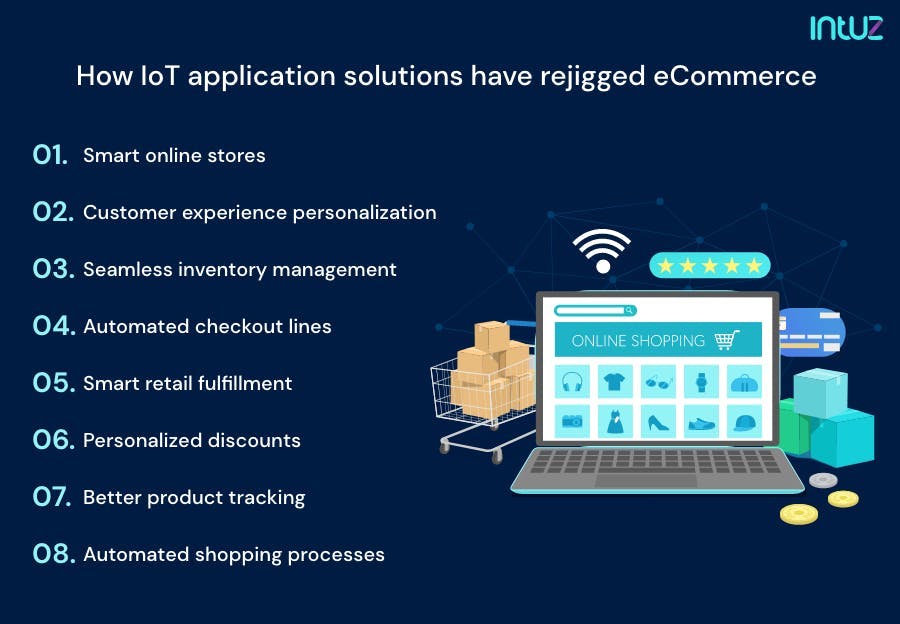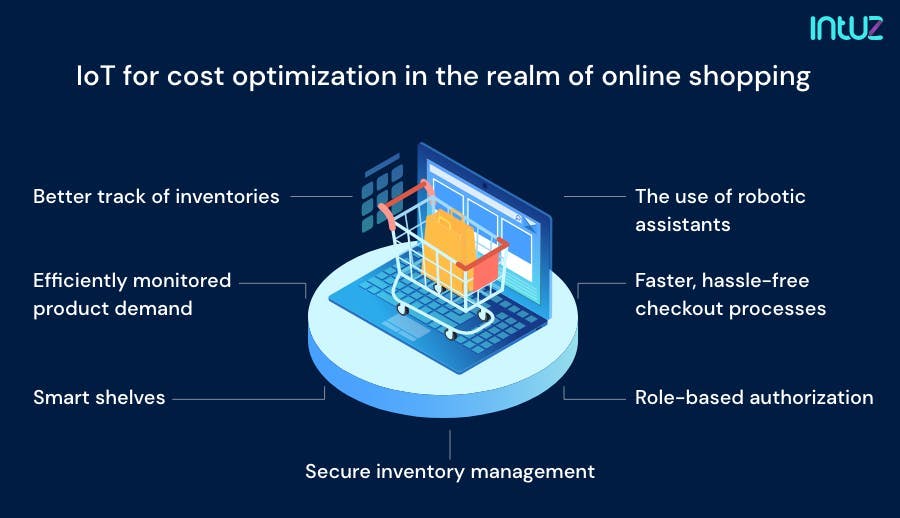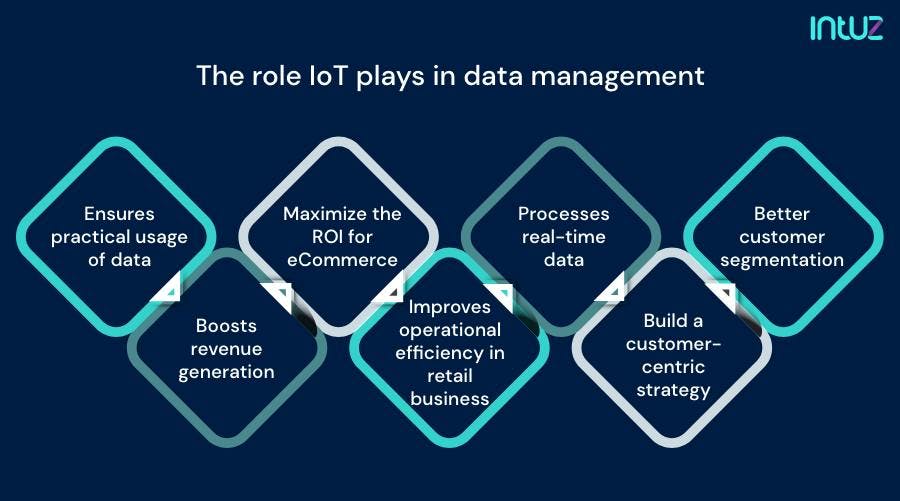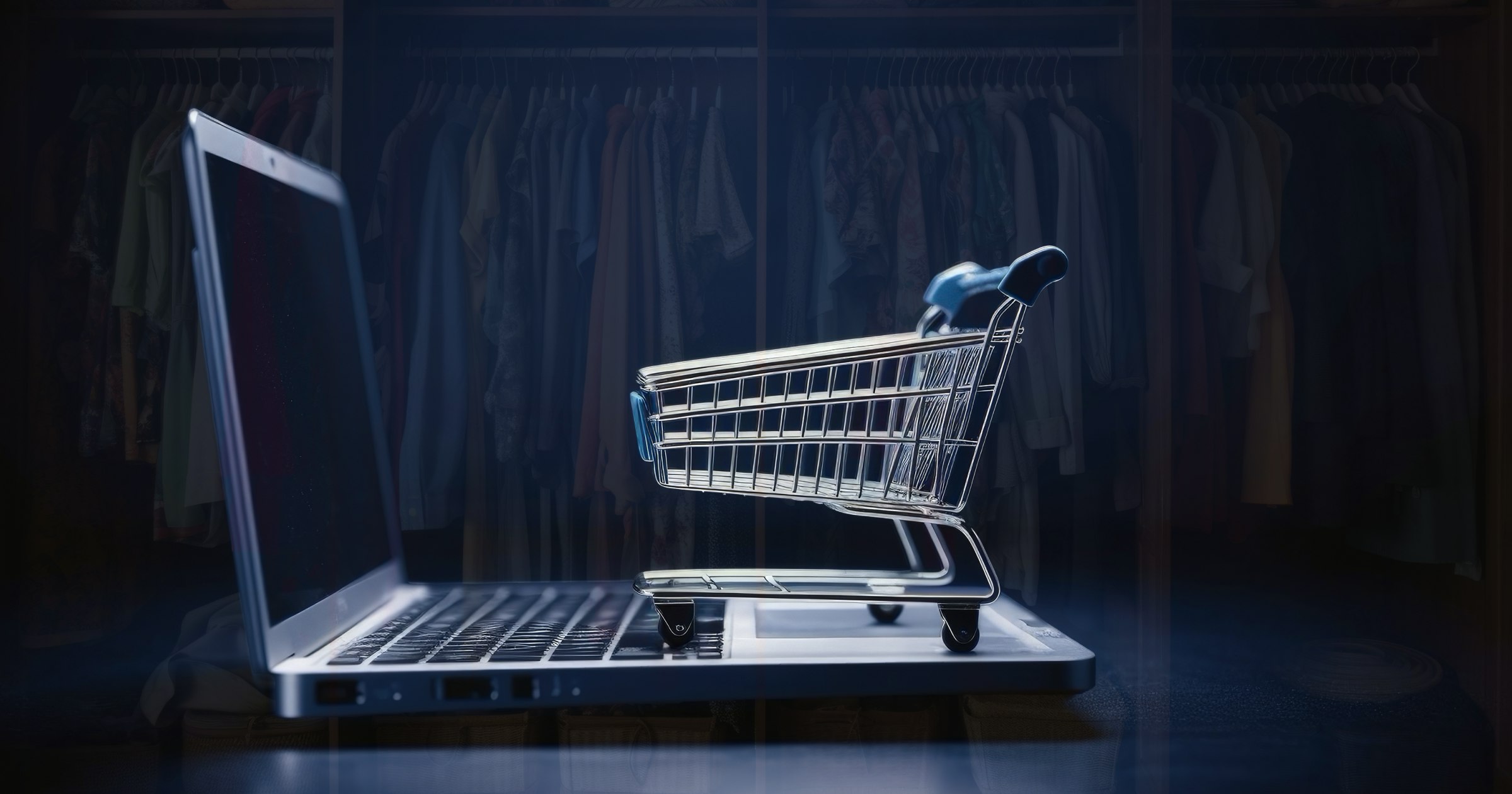Table of Content
Unless you have been living under a rock, you will agree that the Internet of Things (IoT) is a network connecting devices through sensors that communicate, gather, and analyze data.
The IoT application solutions collect data from their physical surroundings and send it over networks to cloud-based software platforms for processing. According to reports, 125 billion IoT devices will be connected worldwide by 2030. That is a huge number indeed!
But it is interesting to see IoT spread its wings so far and wide. From healthcare and logistics to education and hospitality to fintech and automotive — IoT has carved a niche by introducing robust and intuitive applications into the mix.
The role of IoT in eCommerce
The eCommerce industry is no exception either. Offline retailers are finding new ways to harness the power of IoT in eCommerce to have an edge over their competitors. They have revolutionized the world of shopping, moving to more convenient platforms.
For instance, retailers already use internet-connected technologies by deploying sensors to track inventory levels or customer behavior. When we speak solely about online stores, they now have an indispensable power over brick-and-mortar stores in the retail domain.
IoT helps them make better decisions and implement better marketing strategies across stores. Customer service is also more efficient and personalized. The technology has helped retailers build a supply chain that is more transparent and seamless.
With global eCommerce sales expected to touch $6.4 trillion by 2024, we know that this sector is on its way to making great strides. In this article, we will study how IoT has revolutionized every aspect of eCommerce as we know it today:
IoT & connected stores: Revolutionizing retail experiences
The Internet of Things (IoT) is transforming traditional retail into an interconnected ecosystem known as "connected stores." In these stores, smart devices, sensors, and beacons communicate with each other and customers, enhancing convenience and personalization.
IoT enables real-time inventory tracking, automated checkout, personalized promotions, and optimized store layouts based on customer behavior.
Example:
Retail giants like Amazon are pioneers in IoT-connected stores with their Amazon Go stores. These stores allow customers to walk in, grab items, and leave without standing in checkout lines—thanks to IoT sensors, computer vision, and AI working in sync to track purchases and automatically charge the customer's Amazon account.
Are You Ready to Boost Your eCommerce Sales with IoT Integration?
Contact Us NowApplications of IoT in eCommerce

1. Smart online stores
Retailers can now create a better customer experience by deploying IoT-enabled cameras and sensor-based devices at their stores. It improves how consumers connect and interact with products and people at the stores.
Smart stores, for instance, are equipped with smart carts and shelves, products with RFID tags, robotic assistants, and automated checkout systems. Deploying in-store automation helps consumers have a more informed and convenient shopping experience.
On the other hand, retailers benefit from retaining business and increasing revenue through an improved shopping experience. They can personalize marketing communications and gauge demand by utilizing the data collected for retail analytics.
Digital connectivity allows them to stay competitive by offering a seamless online and offline experience. Retailers can also study heat maps of their stores for shopper mapping. It helps them identify active zones and decide the store layout.
They can use the information to display discounted items and other popular products — customized based on the needs of a specific consumer group.
2. Customer experience personalization
Retail businesses adopting IoT enjoy a sustainable competitive advantage. A Salesforce/IDC report has stated that personalized customer experiences lead to higher levels of engagement, loyalty, and profitability.
That is because IoT helps them activate data-driven responses to individual customer interactions in real-time at scale. Retailers use data gathered from IoT devices to deliver personalized customer experiences.
Macro segmentation of consumers can be used to engage them through custom discounts and coupon codes. Personalizing customer interaction across all touchpoints — online and offline, improves the customer experience manifold.
3. Seamless inventory management
IoT addresses the challenge of inventory management for retailers. They can streamline the supply chain by monitoring supply and demand. IoT solutions cut costs and increase customer satisfaction levels by ensuring all products are stocked appropriately.
Technologies such as RFID tags or beacons for proximity sensing allow automated stock monitoring to ensure nothing is out of stock. IoT solves inventory management by giving retailers enough data to forecast demand and scale up stock during peak periods.
IoT In Supply Chain Management: 6 Benefits To Know
Read Now4. Automated checkout lines
Checkout lines are often discouraging for visitors at a physical store and even compel retailers to employ more staff to manage busy hours.
Retailers can save costs and make the process convenient while ensuring they do not lose any potential revenue by automating the checkout process for the sake of driving faster sales.
Installing IoT-based automated Point of Sale (PoS) systems allows self-checkout for customers who do not want to wait in queues. The system reads tags on each product using NFC technology and charges the customer's permitted account for the total amount.
The sensor-based system provides a better customer experience and attracts consumers to shop hassle-free even when there is a time crunch.
5. Smart retail fulfillment
Retailers can use IoT for inventory management. Smart ordering based on demand and optimizing delivery routes makes the process efficient and cuts costs as well. Smart fulfillment allows retailers to ensure the right amount of product is in stock at all times.
GPS-based tracking allows retailers to keep track of their shipments from the warehouse to the store shelves. Automated organization of pallets using IoT sensors and installing RFID tags on inventory saves time and costs spent on searching particular products.
Plus, IoT helps track issues with recalled products, which can potentially cause injuries and make consumers lose trust in brands. It is possible to track individual shipments of items rather than pulling a much larger quantity of items that do not comprise the known defects.
That way, it is possible to determine things like which supplier provider faulty parts while fulfilling the order or find out how the damage happened during shipping.
6. Personalized discounts and other marketing promotions
A retail store's layout can be optimized with the help of beacon technology for aisle analytics. However, it can also be used to send custom notifications for discounts or in-store promotions to consumers pretty smoothly.
For instance, retailers can offer discounts tailored to buyer needs by using IoT solutions, thereby increasing conversion rates. Repeat buyers can be rewarded for their loyalty through these custom discount codes.
Research suggests that 60% of shoppers are engaging with beacon-triggered content, and it even increases their likelihood of purchasing in-store. New customers can be attracted by setting up sensors around the store.
These sensors track daily commuters and visitors of the specified areas around the retailer's location. The system sends them personalized offers on their smartphones via text message or email, inviting them to try the products.
7. Better product tracking — from warehouse to end customer
IoT technology offers retailers the benefit of monitoring inventory from the warehouse to when it arrives at the store. They can track any missing goods with ease and even track home deliveries in real-time.
GPS and RFID technology coupled with IoT sensors provides retailers data such as traffic status, weather conditions, the health of inventory, and location. They can use the data for logistics management and route optimization.
Connecting with vendors, carriers, and teams over the cloud eases collaboration and provide transparency. Drivers can be directly intimated for any required changes in routes. Similarly, RFID tags and beacon sensors can be deployed in-store to keep track of stock.
The information can be used to replenish stock on time. It is also helpful to keep track of items and facilitates automated checkouts.
Connected equipment in a warehouse, for instance, can help monitor movement across the facility, connected products can update real-time inventory, and connected workers can pick up the orders efficiently and swiftly.
8. Automated shopping processes
The recent introduction of automated checkout systems, like Amazon Go, is revolutionizing the buying process. It enables customers to walk in and out of retail stores. They no longer need to get out cash for payment or swipe a credit card.
High-tech sensors installed at the exit automatically charge all purchases, thus saving time. Automating checkout eliminates having any checkout lines or waiting times at billing counters.
Additionally, implementing predictive technology allows retailers to predict when more people purchase goods and what to stock more. They can use the information to appropriately stock-up shelves and vending machines.
IoT for cost optimization in the realm of online shopping
The way IoT reduces costs varies by industry. In eCommerce, IoT saves money by reducing overall maintenance costs, bridging the gap between floor workers and warehouse managers, identifying and resolving bottlenecks in production, and so on. In this section, we will drill down further into examples of specific cost-saving use cases of IoT in eCommerce:
1. Better track of inventories
IoT offers end-to-end visibility in terms of inventory management. It helps reduce inventory storage costs and control losses due to delays. Retailers can also keep track of product quality in case of consumables and fresh food items.
2. Efficiently monitored product demand
Predictive analytics track the demand for products in specified periods. Retailers can stock the items as per demand and manage operational costs.
3. Smart shelves
Yes, they provide data that helps in improving stock placement to promote sales. They also automatically initiate order requests to replenish stock. It ensures that in-demand products are never out of stock and placed at strategic spots.
4. More transparency, fewer chances of fraud in inventory management
IoT reduces losses due to fraud by offering traceability and visibility of inventory through the delivery process. Sensors, for instance, can monitor the movement of a specific order from start to finish with complete ease.

5. The use of robotic assistants
They can cut down the workload of in-store employees, allowing them to engage in more meaningful and complex tasks. More straightforward jobs such as helping customers find specific products and replacing misplaced items are efficiently handled by robots. What a time to be alive!
6. Faster, hassle-free checkout processes
Automating processes such as checkout helps reduce costs and saves time. McKinsey estimates 75% cost savings with automated checkout. Reduction in requirement of cashier staff in 2025 may result in savings of $150 billion to $380 billion a year. Those are some massive cost savings!
7. Role-based authorization
The multi-tenant feature offers retailers the convenience of managing multiple entities from one platform. They can provide each user or tenant access to specific devices. This role-based authorization helps in saving costs and resources by avoiding unnecessary expenses on setting up separate platforms for each entity.
Benefits of IoT in eCommerce
IoT in eCommerce not only streamlines operations but also drives deeper customer engagement. Here are the key benefits:
1. Enhanced customer personalization
IoT enables eCommerce platforms to gather valuable data from connected devices, offering personalized product recommendations based on browsing history, past purchases, and even real-time location. This data-driven approach increases customer satisfaction and boosts sales.
2. Real-time data and analytics
With IoT, retailers can collect real-time data on customer preferences, buying patterns, and in-store movement. This data helps in optimizing marketing campaigns, product placement, and overall sales strategies, making eCommerce operations more agile and efficient.
3. Inventory optimization
IoT allows retailers to track inventory levels in real time across multiple warehouses and stores. This leads to efficient stock management, reducing the chances of overstocking or stockouts. By using IoT-enabled solutions, businesses can also manage supply chains more effectively, avoiding costly delays.
4. Improved customer engagement
Through smart home devices and connected assistants, customers can receive tailored product recommendations or make purchases via voice commands. This creates a more interactive and engaging shopping experience, as IoT integrates with users' everyday lives.
Examples of companies using IoT in E-Commerce
1. Amazon
Amazon continues to lead the way in IoT-powered eCommerce. Its Amazon Go stores are the best example of frictionless shopping, combining IoT sensors, computer vision, and machine learning for a "just walk out" shopping experience. Additionally, Amazon's Alexa smart devices are central to their IoT strategy, enabling voice-based shopping.
2. Alibaba
Alibaba leverages IoT in its “New Retail” strategy by blending offline and online commerce. They have implemented IoT-enabled smart shelves, real-time customer data collection, and connected warehouses, allowing seamless inventory management and a better customer experience.
3. Zara (Inditex)
Zara uses IoT-driven RFID technology for real-time inventory tracking in both physical stores and their online platform. This reduces stock discrepancies and provides customers with accurate product availability, regardless of whether they are shopping online or in-store.
4. JD.com
JD.com, one of China's largest online retailers, uses IoT in warehouse automation and smart logistics. Their IoT-driven warehouse robots and automated delivery systems have significantly reduced operational costs and improved delivery times, giving them a competitive edge.
The role IoT plays in data management
The use of IoT devices and sensor-backed technology in retail is the way forward for retail businesses. However, retail businesses are struggling with the amount of data that is being collected from IoT devices. This is a common problem with IoT across domains.
You see, retail executives do not have enough skills or qualifications to gain valuable insights from the data. The information often becomes overwhelming for them and thus calls for efficient data management. Here is how that can help:

- Integrating IoT systems with data management solutions ensures practical usage of data and boosts revenue generation. The collected data can be processed to produce valuable insights through the integration of APIs with IoT devices.
- Retailers can also maximize the returns of their investments in IoT in eCommerce by hiring domain experts or third-party organizations with relevant qualifications. They help derive actionable insights from the data and improve the operational efficiency of the retail business.
- Efficient data management provides a competitive edge to the retailer by streamlining operations and building a customer-centric strategy. They can use the information to segment customers as per their needs and provide specific solutions.
- An intuitive dashboard can be used that processes real-time data from the IoT devices on the network. It gives retail managers a real-time view of their store by transforming the data gathered from several nodes as actionable insight.
The retailers, in turn, can identify opportunities and prospects to act on them. A comparative analysis will give as well an understanding of their current and past usage and help them make business decisions accordingly.
Ready to Make Your eCommerce Platform Smarter with IoT Integration?
Explore ServicesOver to you
Retailers are always looking for ways to improve their customer's experience and increase business. Implementing IoT solutions into stores helps them convert more customers into loyal shoppers, and for a good reason.
Gaining valuable insights on demand patterns provides retailers with enough information to understand their target audience. They can use it to design better business strategies to promote a higher level of engagement.
If you are looking to change how you are running things at your eCommerce firm, now is the time to give it a facelift with IoT and partner with someone who can help you achieve your business objectives.
Having said that, why not have a consultation with our team, who is an expert in IoT eCommerce app development and has worked on numerous projects before?
Book a 45-minute consultation with our eCommerce IoT experts and get a free roadmap or strategy for IoT integration in your eCommerce store.

